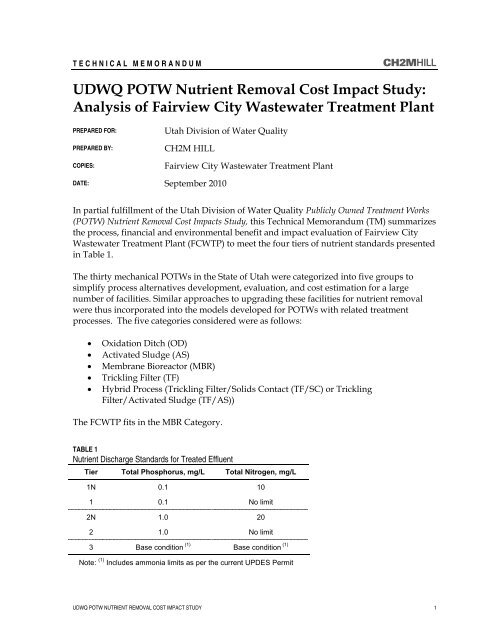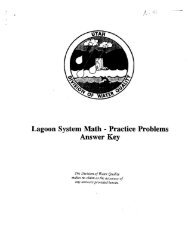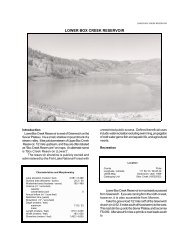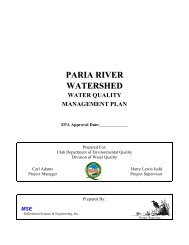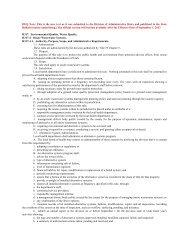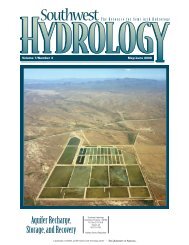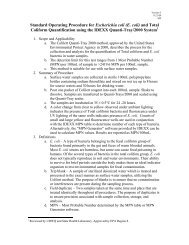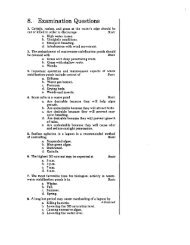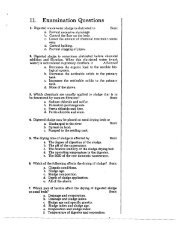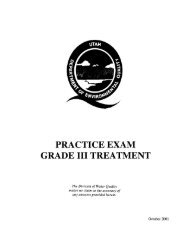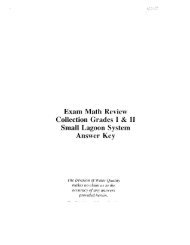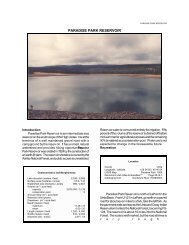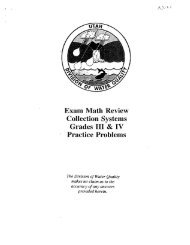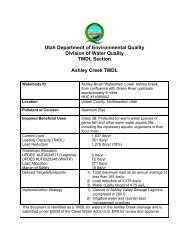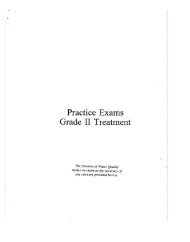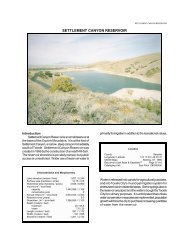Fairview City WWTP - Division of Water Quality
Fairview City WWTP - Division of Water Quality
Fairview City WWTP - Division of Water Quality
You also want an ePaper? Increase the reach of your titles
YUMPU automatically turns print PDFs into web optimized ePapers that Google loves.
TECHNICAL MEMORANDUM<br />
UDWQ POTW Nutrient Removal Cost Impact Study:<br />
Analysis <strong>of</strong> <strong>Fairview</strong> <strong>City</strong> Wastewater Treatment Plant<br />
PREPARED FOR:<br />
PREPARED BY:<br />
COPIES:<br />
Utah <strong>Division</strong> <strong>of</strong> <strong>Water</strong> <strong>Quality</strong><br />
CH2M HILL<br />
<strong>Fairview</strong> <strong>City</strong> Wastewater Treatment Plant<br />
DATE: September 2010<br />
In partial fulfillment <strong>of</strong> the Utah <strong>Division</strong> <strong>of</strong> <strong>Water</strong> <strong>Quality</strong> Publicly Owned Treatment Works<br />
(POTW) Nutrient Removal Cost Impacts Study, this Technical Memorandum (TM) summarizes<br />
the process, financial and environmental benefit and impact evaluation <strong>of</strong> <strong>Fairview</strong> <strong>City</strong><br />
Wastewater Treatment Plant (FCWTP) to meet the four tiers <strong>of</strong> nutrient standards presented<br />
in Table 1.<br />
The thirty mechanical POTWs in the State <strong>of</strong> Utah were categorized into five groups to<br />
simplify process alternatives development, evaluation, and cost estimation for a large<br />
number <strong>of</strong> facilities. Similar approaches to upgrading these facilities for nutrient removal<br />
were thus incorporated into the models developed for POTWs with related treatment<br />
processes. The five categories considered were as follows:<br />
• Oxidation Ditch (OD)<br />
• Activated Sludge (AS)<br />
• Membrane Bioreactor (MBR)<br />
• Trickling Filter (TF)<br />
• Hybrid Process (Trickling Filter/Solids Contact (TF/SC) or Trickling<br />
Filter/Activated Sludge (TF/AS))<br />
The FCWTP fits in the MBR Category.<br />
TABLE 1<br />
Nutrient Discharge Standards for Treated Effluent<br />
Tier Total Phosphorus, mg/L Total Nitrogen, mg/L<br />
1N 0.1 10<br />
1 0.1 No limit<br />
2N 1.0 20<br />
2 1.0 No limit<br />
3 Base condition (1) Base condition (1)<br />
Note: (1) Includes ammonia limits as per the current UPDES Permit<br />
UDWQ POTW NUTRIENT REMOVAL COST IMPACT STUDY 1
FAIRVIEW CITY WASTEWATER TREATMENT PLANT<br />
1. Facility Overview<br />
This facility is designed for an average flow <strong>of</strong> 0.375 million gallons per day (mgd) and<br />
currently receives an average annual influent flow <strong>of</strong> approximately 0.07 mgd. The facility<br />
operates an anoxic/aerobic activated sludge process ahead <strong>of</strong> the MBRs to treat its influent<br />
wastewater. The secondary effluent is discharged to the receiving water after disinfection.<br />
Currently FCWTP is regulated for BOD and TSS. Residual secondary solids generated from<br />
the process are mechanically dewatered using a belt press and disposed <strong>of</strong> in a landfill. A<br />
process flow diagram <strong>of</strong> the existing facility is presented in Figure 1 and the major existing<br />
unit processes are listed in Table 2.<br />
FIGURE 1<br />
Process Flow Diagram<br />
TABLE 2<br />
Summary <strong>of</strong> Major Unit Processes<br />
Unit Process Number <strong>of</strong> Units Size, Each Details<br />
Anoxic basins 2 14,000 gal. 7-ft SWD Rectangular<br />
Pre-aeration basin 2 28,500 gal Fine bubble diffused aeration<br />
Membrane basins 2 35,000 gal, 10-ft SWD Flat plate-type membranes<br />
Dewatering 1 0.75 meter Belt filter press<br />
2. Nutrient Removal Alternatives Development, Screening and Selection<br />
For all the other treatment categories, a nutrient removal alternatives matrix was prepared<br />
to capture an array <strong>of</strong> viable approaches to meet the various Tiers <strong>of</strong> nutrient control. This<br />
was not done for the MBR category as they are inherently capable <strong>of</strong> achieving 1 mg/L total<br />
phosphorus and 10 mg/L total nitrogen limit. The most viable approach to upgrade the<br />
MBR facilities was to implement chemical phosphorus removal. The processes that were<br />
UDWQ POTW NUTRIENT REMOVAL COST IMPACT STUDY 2
FAIRVIEW CITY WASTEWATER TREATMENT PLANT<br />
modeled and described in subsequent sections are considered proven methods for meeting<br />
the nutrient limits. There may be other ways to further optimize the process to reduce<br />
capital and operation and maintenance (O&M) costs that are beyond the scope <strong>of</strong> this<br />
project. This TM can form the basis for an optimization study in the future should that be<br />
desired by the POTW.<br />
FCWTP operates all <strong>of</strong> the facilities listed in Table 2 and is able to achieve biological nutrient<br />
removal to a certain extent. A goal <strong>of</strong> this project was to make maximum use <strong>of</strong> the existing<br />
infrastructure in the upgrade approaches selected for meeting the various tiers <strong>of</strong> nutrient<br />
limits. Upgrades were added to the system models as required to meet increasingly<br />
stringent discharge limits. Figure 2 shows the basic upgrade approach used between each<br />
tier <strong>of</strong> nutrient control with the bullet points A through D below describing each upgrade<br />
step:<br />
A. From Tier 3 (existing) to Tier 2 phosphorus control, a metal-salt addition system<br />
was initiated ahead <strong>of</strong> the MBR basins to be operated only as required to achieve<br />
chemical phosphorus removal.<br />
B. From Tier 2 to Tier 2N, no additional process modifications were required.<br />
C. To go from Tier 2 to Tier 1 level <strong>of</strong> phosphorus control, higher doses <strong>of</strong> metal-salt<br />
was added ahead <strong>of</strong> the membrane basins to bring down the effluent phosphorus<br />
concentration to 0.1 mg/L.<br />
D. To add nitrogen removal to Tier 1, no additional process modifications were<br />
required.<br />
FIGURE 2<br />
Upgrades Scheme for Meeting Increasingly More Stringent Nutrient Control<br />
Data Evaluation and Modeling <strong>of</strong> Upgrades<br />
The selected progression <strong>of</strong> the upgrades conceived for meeting the different tiers <strong>of</strong><br />
nutrient control for FCWTP was analyzed using the following four steps;<br />
Step 1.<br />
Review, compile, and summarize the process performance data<br />
submitted by the POTW;<br />
UDWQ POTW NUTRIENT REMOVAL COST IMPACT STUDY 3
FAIRVIEW CITY WASTEWATER TREATMENT PLANT<br />
Step 2. Develop and calibrate a base model <strong>of</strong> the existing POTW using the<br />
summarized performance data;<br />
Step 3. Build upon the base model by sequentially modifying it to incorporate<br />
unit process additions or upgrades for the different tiers <strong>of</strong> nutrient<br />
control and use model outputs to establish unit process sizing and<br />
operating requirements;<br />
Step 4. Develop capital and O&M costs for each upgrade developed in Step 3.<br />
The facility information and data received from David Nuttall <strong>of</strong> FCWTP during the<br />
October 2009 workshop and through follow-up emails was evaluated to (a) develop and<br />
validate the base process model, and (b) size facilities to conserve the POTW’s current rated<br />
capacity. Table 3 provides a summary <strong>of</strong> the reported information used as the model input<br />
conditions. See Process Modeling Protocol (Attachment B) for additional information.<br />
TABLE 3<br />
Summary <strong>of</strong> Input Conditions<br />
Input Parameter 2009 (1) 2029 (2) Design (3)<br />
Flow, mgd 0.07 0.20 0.45<br />
BOD, lb/day 140 (240 mg/L) 400 (240 mg/L) 900 (240 mg/L)<br />
TSS, lb/day 117 (200 mg/L) 335 (200 mg/L) 750 (200 mg/L)<br />
TKN, lb/day 32 (50 mg/L) 85 (50 mg/L) 190 (50 mg/L)<br />
TP, lb/day 4 (6 mg/L) 10 (6 mg/L) 23 (6 mg/L)<br />
(1) Historic conditions 2007-2009<br />
(2) Assumed based on increase in population from Census report<br />
(3) Estimated design maximum month capacity <strong>of</strong> POTW. Assumed 1.2 times (peaking factor) the design<br />
annual average flow provided by the POTW<br />
The main sizing and operating design criteria that were important for capturing the costs<br />
associated with the system upgrades for FCWTP are summarized in Table 4.<br />
TABLE 4<br />
Main Unit Process Sizing and Operating Design Parameters<br />
Design Parameter (Nutrient Tier)<br />
Influent design temperature<br />
Value<br />
10 deg C<br />
Target metal:PO 4 -P molar Ratio (All tiers) (1) 2:1<br />
Metal salt storage capacity (Tier2 and Tier2N)<br />
5 days<br />
Metal salt storage (Tier1 and Tier1N)<br />
14 days<br />
Membrane flux rate 12 gpm/ft 2<br />
(1) Target dosing ratio ahead <strong>of</strong> the MBR tanks<br />
UDWQ POTW NUTRIENT REMOVAL COST IMPACT STUDY 4
FAIRVIEW CITY WASTEWATER TREATMENT PLANT<br />
3. Nutrient Upgrade Approaches<br />
The following paragraphs provide details <strong>of</strong> the upgrade approaches for the different Tiers<br />
<strong>of</strong> nutrient control as presented previously in Figure 3.<br />
Tier 2 Phosphorus (A)<br />
The effluent limit for Tier 2 alternative is 1.0 mg/L total phosphorus. According to process<br />
modeling, FCWTP is able to achieve this limit with their existing infrastructure and mode <strong>of</strong><br />
operation. However, a metal-salt feed point was added to the existing facilities ahead <strong>of</strong> the<br />
MBR basins as a backup to biological phosphorus removal. This feed point would be<br />
operated as required for chemical phosphorus removal if and when the existing process fails<br />
to achieve the phosphorus limit. A process flow diagram for this treatment approach is<br />
presented in Figure 3. The upgrades are indicated in red.<br />
FIGURE 3<br />
Modifications to POTW for Tier 2 Nutrient Control<br />
Tier 2N – Phosphorus & Nitrogen (B)<br />
The metal-salt feed point ahead <strong>of</strong> the MBR basins added in Tier 2 would not require any<br />
adjustments or modification to achieve moderate levels <strong>of</strong> nitrogen control for this Tier<br />
along with phosphorus control. The existing process is already exhibiting sufficient<br />
biological nitrogen removal to meet this limit; therefore, the process flow diagram for this<br />
approach would be the same as presented in Figure 3.<br />
Tier 1 Phosphorus (C)<br />
Upgrades to this alternative would essentially be the same as the Tier 2 approach for<br />
phosphorus control, thus the process flow diagram would be the same as presented in<br />
Figure 3. However, greater and regular application rate <strong>of</strong> metal-salt would be required to<br />
bring down the effluent phosphorus concentration to 0.1 mg/L, thus requiring an expansion<br />
<strong>of</strong> the feed facility proposed for Tier 2 and 2N.<br />
UDWQ POTW NUTRIENT REMOVAL COST IMPACT STUDY 5
FAIRVIEW CITY WASTEWATER TREATMENT PLANT<br />
Tier 1N Phosphorus & Nitrogen (D)<br />
The approach and process flow diagram for this approach would be the same as presented<br />
for Tier 1 level <strong>of</strong> phosphorus control. The existing process is already exhibiting sufficient<br />
biological nitrogen removal to meet the limits <strong>of</strong> this alternative.<br />
4. Capital and O&M Cost Estimates for Nutrient Control<br />
This section summarizes the cost-impact results from the nutrient control process analysis.<br />
These outputs were used in the financial cost model and subsequent financial analyses.<br />
Table 5 presents a summary <strong>of</strong> the major components identified for facility upgrades in<br />
order to meet the various Tiers <strong>of</strong> nutrient standards. For all the Tiers, a metal-salt storage<br />
facility and new metal-salt feed pumps were installed ahead <strong>of</strong> the MBR basins. It was<br />
assumed that the building that houses the existing anoxic, aerobic and MBR basins has<br />
sufficient space to house the metal-salt storage and pump systems.<br />
TABLE 5<br />
Major Facility Upgrade Summary<br />
Processes Tier 2 Tier 2N Tier 1 Tier 1N<br />
Metal-salt feed pumps and storage facility X X X X<br />
The capital cost estimates shown in Table 6 were generated for the facility upgrades<br />
summarized in Table 5. These estimates were prepared in accordance with the guidelines <strong>of</strong><br />
the Association for the Advancement <strong>of</strong> Cost Engineering (AACE) International and defined<br />
as a Class 4 estimate. The expected accuracy range for the estimates shown in Table 6 is<br />
-30%/+50%.<br />
TABLE 6<br />
Capital Cost Estimates<br />
Unit Process Facility Tier 2 Tier 2N Tier 1 Tier 1N<br />
Metal-salt feed pumps and storage<br />
facility<br />
$120,923 $120,923 $314,401 $314,401<br />
TOTAL TIER COST $120,923 $120,923 $314,401 $314,401<br />
December 2009 US Dollars<br />
Incremental O&M costs associated with meeting each tier <strong>of</strong> nutrient standard were<br />
generated for the years 2009 and 2029. The unit O&M costs were either provided by the<br />
POTW or assumed based on the average costs in the State <strong>of</strong> Utah, and are presented in<br />
Table 7. A straight line interpolation was used to estimate the differential cost for the two<br />
years. O&M estimates for each upgrade included the following components:<br />
• Biosolids management: hauling, and disposal<br />
UDWQ POTW NUTRIENT REMOVAL COST IMPACT STUDY 6
FAIRVIEW CITY WASTEWATER TREATMENT PLANT<br />
• Chemical consumption costs: metal-salt, and polymer.<br />
No energy costs were included because the energy required to operate the metal-salt feed<br />
pumps would be insignificant when compared to the total energy <strong>of</strong> the facility.<br />
TABLE 7<br />
Operating and Maintenance Unit Costs<br />
Parameter<br />
Biosolids hauling<br />
Biosolids tipping fee (1)<br />
Round trip hauling distance (2)<br />
Ferric chloride<br />
Polymer<br />
Value<br />
$8/wet ton<br />
$30/wet ton<br />
96 miles<br />
$1000/ton<br />
$1/lb<br />
(1) Tipping/disposal fee provided by the POTW<br />
(2)<br />
Round trip hauling distance to the landfill provided by the POTW<br />
Increased O&M relative to the current O&M cost (Tier 3) are presented in Table 8 and<br />
shown graphically in Figure 4.<br />
TABLE 8<br />
Estimated Impact <strong>of</strong> Nutrient Control on O&M Costs<br />
Tier 2 Tier 2N Tier 1 Tier 1N<br />
2009 2029 2009 2029 2009 2029 2009 2029<br />
Biosolids (1) $0 $0 $0 $0 $1,293 $2,596 $1,293 $2,596<br />
Metal-salt<br />
Polymer<br />
Total O&M<br />
$64 $150 $64 $150 $12,775 $31,025 $12,775 $31,025<br />
$36 $50 $36 $50 $232 $579 $232 $579<br />
$100 $200 $100 $200 $14,300 $34,200 $14,300 $34,200<br />
Note: $ (US) in December 2009.<br />
Costs shown are the annual differential costs relative to the base line O&M cost <strong>of</strong> the POTW<br />
erential O&M Cost ($)<br />
$40,000<br />
Tier 2 and 2N<br />
$35,000<br />
Tier 1 and 1N<br />
$30,000<br />
$25,000<br />
UDWQ POTW NUTRIENT REMOVAL COST IMPACT STUDY 7<br />
$20,000<br />
$15,000
FAIRVIEW CITY WASTEWATER TREATMENT PLANT<br />
FIGURE 4<br />
Impact <strong>of</strong> Nutrient Control on O&M Costs over 20 year evaluation period<br />
5. Financial Impacts<br />
This section presents the estimated financial impacts that would result from the<br />
implementation <strong>of</strong> nutrient discharge standards for the FCWTP. Financial impacts were<br />
summarized for each POTW on the basis <strong>of</strong> three primary economic parameters: 20-year life<br />
cycle costs, user charge impacts, and community financial impacts. The basis for the<br />
financial impact analysis is the estimated capital and incremental O&M costs established in<br />
the previous sections.<br />
Life Cycle Costs<br />
Life cycle cost analysis refers to an assessment <strong>of</strong> the costs over the life <strong>of</strong> a project or asset,<br />
emphasizing the identification <strong>of</strong> cost requirements beyond the initial investment or capital<br />
expenditure.<br />
For each treatment upgrade established to meet the studied nutrient limits (Tier 2, Tier 2N,<br />
Tier 1, and Tier 1N), a multi-year life cycle cost forecast was developed that is comprised <strong>of</strong><br />
both capital and O&M costs. Cost forecasts are organized with initial capital expenditures in<br />
year 0 (2009), and incremental O&M forecasts from year 1 (2010) through year 20 (2029). The<br />
cost forecast for each treatment alternative was developed in current (2009) dollars, and<br />
discounted to yield the net present value (NPV).<br />
The NPV was divided by the estimated 20-year nutrient discharge mass reduction for each<br />
tier, resulting in a cost per pound estimate for nutrient removal. This calculation represents<br />
an appropriate matching <strong>of</strong> costs with receiving stream load reduction over the same time<br />
period. Table 9 presents the results <strong>of</strong> the life cycle cost analysis for FCWTP.<br />
UDWQ POTW NUTRIENT REMOVAL COST IMPACT STUDY 8
FAIRVIEW CITY WASTEWATER TREATMENT PLANT<br />
TABLE 9<br />
Nutrient Removal: 20-Year Life Cycle Cost per Pound 1<br />
Tier 2 Tier 2N Tier 1 Tier 1N<br />
Phosphorus Removal (pounds) 2 meets limit meets limit 7,579 7,579<br />
Nitrogen Removal (pounds) 2 - meets limit - meets limit<br />
Net Present Value <strong>of</strong> Removal Costs 3 $ 123,266 $ 123,266 $ 679,182 $ 679,182<br />
NPV: Phosphorus Allocation 123,266 123,266 679,182 679,182<br />
NPV: Nitrogen Allocation 4 - -<br />
TP Cost per Pound 5 NA NA $ 89.62 $ 89.62<br />
TN Cost per Pound 5 NA NA<br />
1 - For facilities that are already meeting one or more nutrient limits, "meets limit" is displayed for nutrient removal mass and "NA" is<br />
displayed for cost per pound metrics<br />
2 - Total nutrient removal over a 20-year period, from 2010 through 2029<br />
3 - Net present value <strong>of</strong> removal costs, including capital expenditures and incremental O&M over a 20-year period<br />
4 - For simplicity, it w as assumed that the nitrogen cost allocation w as the incremental difference betw een net present value costs<br />
across Tiers for the same phosphorus limit (i.e. Tier 2 to Tier 2N); differences in technology recommendations may result in different<br />
cost allocations for some facilities<br />
5 - Cost per pound metrics measured over a 20-year period are used to compare relative nutrient removal efficiencies among<br />
treatment alternatives and different facilities<br />
Customer Financial Impacts<br />
The second financial parameter measures the potential impact to user rates for customers<br />
served by the POTW. The financial impact is measured both in terms <strong>of</strong> potential rate<br />
increases for the POTW’s associated service provider, and the resulting monthly bill impacts<br />
for the typical residential customer <strong>of</strong> the system.<br />
Customer impacts were estimated by calculating annual increased revenue requirements for<br />
the POTW. Implementation <strong>of</strong> each treatment upgrade will increase the annual revenue<br />
requirements for debt service payments (related to initial capital cost) and incremental O&M<br />
costs.<br />
The annual cost increase was then divided by the number <strong>of</strong> customers served by the<br />
POTW, as measured by equivalent residential units (ERUs), to establish a monthly rate<br />
increase per ERU. The monthly rate increase associated with each treatment alternative was<br />
estimated by adding the projected monthly rate increase to the customer’s current average<br />
monthly bill. Estimated financial impacts for customers <strong>of</strong> the FCWTP are presented in<br />
Table 10.<br />
UDWQ POTW NUTRIENT REMOVAL COST IMPACT STUDY 9
FAIRVIEW CITY WASTEWATER TREATMENT PLANT<br />
TABLE 10<br />
Projected Monthly Bill Impact per Equivalent Residential Unit (ERU) for Treatment Alternatives<br />
Tier 2 Tier 2N Tier 1 Tier 1N<br />
Initial Capital Expenditure $ 121,000 $ 121,000 $ 314,000 $ 314,000<br />
Estimated Annual Debt Service 1 $ 9,700 $ 9,700 $ 25,200 $ 25,200<br />
Incremental Operating Cost 2 200 200 15,300 15,300<br />
Total Annual Cost Increase $ 9,900 $ 9,900 $ 40,500 $ 40,500<br />
Number <strong>of</strong> ERUs 630 630 630 630<br />
Annual Cost Increase per ERU $15.71 $15.71 $64.29 $64.29<br />
Monthly Cost Increase per ERU 3 $1.31 $1.31 $5.36 $5.36<br />
Current Average Monthly Bill 4 $37.50 $37.50 $37.50 $37.50<br />
Projected Average Monthly Bill 5 $38.81 $38.81 $42.86 $42.86<br />
Percent Increase 3.5% 3.5% 14.3% 14.3%<br />
1 - Assumes a financing term <strong>of</strong> 20 years and an interest rate <strong>of</strong> 5.0 percent<br />
2 - Incremental annual increase in O&M for each upgrade, based on chosen treatment technology, estimated for first operational<br />
year<br />
3 - Projected monthly bill impact per ERU for each upgrade, based on estimated increase in annual operating costs<br />
4 - Estimated 2009 average monthly bill for a typical residential customer (ERU) w ithin the service area <strong>of</strong> the facility<br />
5 - Projected average monthly bill for a typical residential customer (ERU) if treatment upgrade is implemented<br />
Community Financial Impacts<br />
The third and final parameter measures the financial impact <strong>of</strong> nutrient limits from a<br />
community perspective, and accounts for the varied purchasing power <strong>of</strong> customers<br />
throughout the state. The metric is the ratio <strong>of</strong> the projected monthly bill that would result<br />
from each treatment alternative to an affordable monthly bill, based on a parameter<br />
established by the State <strong>Water</strong> <strong>Quality</strong> Board to determine project affordability.<br />
The <strong>Division</strong> employs an affordability criterion that is widely used to assess the<br />
affordability <strong>of</strong> projects. The affordability threshold is equal to 1.4 percent <strong>of</strong> the median<br />
annual gross household income (MAGI) for customers served by a POTW. The MAGI<br />
estimate for customers <strong>of</strong> each POTW is multiplied by the affordability threshold parameter,<br />
then divided by 12 (months) to determine the monthly ‘affordable’ wastewater bill for the<br />
typical customer.<br />
The projected monthly bill for each nutrient limit was then expressed as a percentage <strong>of</strong> the<br />
monthly affordable bill. The resulting affordability ratio for each nutrient limit for the<br />
FCWTP is shown in Table 11.<br />
UDWQ POTW NUTRIENT REMOVAL COST IMPACT STUDY 10
FAIRVIEW CITY WASTEWATER TREATMENT PLANT<br />
TABLE 11<br />
Community Financial Impacts: Affordability <strong>of</strong> Treatment Alternatives<br />
Tier 2 Tier 2N Tier 1 Tier 1N<br />
Median Annual Gross Income (MAGI) 1,2 $ 35,000 $ 35,000 $ 35,000 $ 35,000<br />
Affordability Threshold (% <strong>of</strong> MAGI) 3 1.4% 1.4% 1.4% 1.4%<br />
Monthly Affordability Criterion $40.83 $40.83 $40.83 $40.83<br />
Projected Average Monthly Bill $38.81 $38.81 $42.86 $42.86<br />
Meets State's Affordability Criterion Yes Yes No No<br />
Estimated Bill as % <strong>of</strong> State Criterion 95% 95% 105% 105%<br />
1 - Based on the average MAGI <strong>of</strong> customers w ithin the service area <strong>of</strong> the facility<br />
2 - MAGI statistics compiled from 2008 census data<br />
3 - Parameter established by the State <strong>Water</strong> <strong>Quality</strong> Board to determine project affordability for POTWs<br />
6. Environmental Impacts <strong>of</strong> Nutrient Control Analysis<br />
This section summarizes the potential environmental benefits and impacts that would result<br />
from implementing the process upgrades established for the various tiers <strong>of</strong> nutrient control<br />
detailed in Section 3. The following aspects were considered for this evaluation:<br />
• Reduction <strong>of</strong> nutrient loads from POTW to receiving water bodies<br />
• Changes in chemical consumption<br />
• Changes in biosolids production<br />
• Changes in emissions from biosolids hauling.<br />
Changes in energy consumption from the proposed upgrades were insignificant and thus<br />
were not considered.<br />
As per the data received from FCWTP and per process modeling <strong>of</strong> the base condition (Tier<br />
3), FCWTP is able to meet an effluent total nitrogen concentration <strong>of</strong> 10 mg/L and Tier 2<br />
level <strong>of</strong> phosphorus control with its existing infrastructure. Table 12 summarizes the annual<br />
reduction in nutrient loads in FCWTP effluent discharge if the process upgrades were<br />
implemented. The values shown are for the current (2009) flow and load conditions. It<br />
should be noted that any increase in flow or load to the POTW will result in higher<br />
reductions.<br />
TABLE 12<br />
Estimated Environmental Benefits <strong>of</strong> Nutrient Control<br />
Tier 2 Tier 2N Tier 1 Tier 1N<br />
Total phosphorus removed, lb/year 0 0 192 192<br />
Total nitrogen removed, lb/year ---- 0 ---- 0<br />
Note: Nutrient loads shown are the annual differential loads relative to the baseline (Tier 3)<br />
condition <strong>of</strong> the POTW for the year 2009.<br />
UDWQ POTW NUTRIENT REMOVAL COST IMPACT STUDY 11
FAIRVIEW CITY WASTEWATER TREATMENT PLANT<br />
The nutrient content <strong>of</strong> POTWs’ discharges and their receiving waters were also<br />
summarized to examine the potential <strong>of</strong> various treatment alternatives for reducing nutrient<br />
loads to those water bodies. The POTW loads were paired with estimated loads in the<br />
upstream receiving waters to create estimated downstream combined loads. Those<br />
combined stream and POTW loads could then be examined for the potential effects <strong>of</strong> future<br />
POTW nutrient removal alternatives. The average total nitrogen and phosphorus<br />
concentrations discharged by each POTW were either provided by the POTW during the<br />
data collection process or obtained from process modeling efforts. Upstream receiving<br />
historical water quality data was obtained from STORET. Data from STORET was<br />
summarized in order to yield average total nitrogen and total phosphorus concentrations<br />
that could then be paired with the appropriate POTW records. It should be noted that the<br />
data obtained from STORET were not verified by sampling and possible anomalies and<br />
outliers could exist in historical data sets due to certain events or errors in measurement.<br />
Currently FCWTP discharges to the San Pitch River. Table 13 shows the total phosphorus<br />
and total nitrogen concentration discharged by FCWTP to the San Pitch River for baseline<br />
condition (Tier 3) and for each Tier <strong>of</strong> nutrient standard. The STORET ID from where<br />
historical water quality data were obtained is also presented in the Table.<br />
TABLE 13<br />
Estimates <strong>of</strong> Average TN and TP Concentrations for Baseline and Cumulative Treatments to Receiving <strong>Water</strong>s (mg/L)<br />
Tier 3 Tier 2 Tier 2N Tier 1 Tier 1N<br />
STORET<br />
LOCATION<br />
STORET<br />
ID<br />
FLOW<br />
(cfs)<br />
TP TN TP TN TP TN TP TN TP TN<br />
FCWTP ---- 0.108 1.0 10 1.0 N/A 1.0 20 0.1 N/A 0.1 10<br />
San Pitch<br />
River<br />
4946840 10.472 0.024 0.98 ---- ---- ---- ---- ---- ---- ---- ----<br />
Combined Concentration 0.034 1.072 0.034 N/A 0.034 1.072 0.025 N/A 0.025 1.072<br />
The process upgrades established to meet the four tiers <strong>of</strong> nutrient standards require<br />
increased chemical consumption and biosolids production. Metal-salt would need to be<br />
added to meet the more stringent phosphorus limits. This would generate more chemical<br />
sludge and consequently result to increased biosolids production. Table 14 summarizes<br />
these environmental impacts <strong>of</strong> implementing the process upgrades to achieve the various<br />
tiers <strong>of</strong> nutrient control. The values shown are on an annual basis, for the current (2009) flow<br />
and load conditions, and indicate the differential relative to the base line condition.<br />
UDWQ POTW NUTRIENT REMOVAL COST IMPACT STUDY 12
FAIRVIEW CITY WASTEWATER TREATMENT PLANT<br />
TABLE 14<br />
Estimated Environmental Impacts <strong>of</strong> Nutrient Control<br />
Chemical Use:<br />
Metal-salt use, lb/year<br />
Biosolids Management:<br />
Tier 2 Tier 2N Tier 1 Tier 1N<br />
100 100 29,200 29,200<br />
Biosolids to disposal, ton/year<br />
0 0 6 6<br />
Additional hauling distance, miles/year 0 0 96 96<br />
Particulate emissions from hauling trucks, lb/year (1) 0 0 5 5<br />
Tailpipe emissions from hauling trucks, lb/year (2) 0 0 12 12<br />
CO 2 emissions from hauling trucks lb/year (3) 0 0 1,200 1,200<br />
Note: Values shown are the annual differential values relative to the base line condition (Tier 3) <strong>of</strong> the POTW for<br />
the year 2009<br />
(1) Includes PM 10 and PM 2.5 emissions in pounds per year. The emission factors to estimate particulate<br />
emissions were derived using the equations from AP-42, Fifth Edition, Vol. I, Section 13.2.1.: Paved Roads<br />
(11/2006).<br />
(2) Tailpipe emissions in pounds per year resulting from diesel combustion <strong>of</strong> hauling trucks were based on<br />
Emission standards Reference guide for Heavy-Duty and Nonroad Engines, EPA420-F-97-014 September<br />
1997. It was assumed that the trucks would meet the emission standards for 1998+.<br />
(3) CO 2 emission factor in pounds per year for hauling trucks were derived from Rosso and Chau, 2009, WEF<br />
Residuals and Biosolids Conference Proceedings.<br />
UDWQ POTW NUTRIENT REMOVAL COST IMPACT STUDY 13


